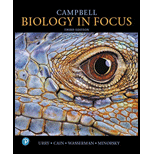
CAMPBELL BIOLOGY IN FOCUS-W/MASTR.BIO.
3rd Edition
ISBN: 9780134875040
Author: Urry
Publisher: PEARSON
expand_more
expand_more
format_list_bulleted
Concept explainers
Textbook Question
Chapter 7, Problem 5TYU
What is the oxidizing agent in the following reaction?
- A. oxygen
- B. NADH
- C. lactate
- D. pyruvate
Expert Solution & Answer
Want to see the full answer?
Check out a sample textbook solution
Students have asked these similar questions
Explain in a small summary how:
What genetic information can be obtained from a Punnet square? What genetic information cannot be determined from a Punnet square?
Why might a Punnet Square be beneficial to understanding genetics/inheritance?
In a small summary write down:
Not part of a graded assignment, from a past midterm
Chapter 7 Solutions
CAMPBELL BIOLOGY IN FOCUS-W/MASTR.BIO.
Ch. 7.1 - Compare and contrast aerobic and anaerobic...Ch. 7.1 - Name and describe the two ways in which ATP is...Ch. 7.1 - Prob. 3CCCh. 7.2 - During step 6 in Figure 7.9, which molecule acts...Ch. 7.3 - Name the molecules that conserve most of the...Ch. 7.3 - Prob. 2CCCh. 7.4 - Prob. 1CCCh. 7.4 - Prob. 2CCCh. 7.4 - MAKE CONNECTIONS Membranes must be fluid to...Ch. 7.5 - Prob. 1CC
Ch. 7.5 - WHAT IF? A glucose-fed yeast cell is moved from an...Ch. 7.6 - MAKE CONNECTIONS Compare the structure of a fat...Ch. 7.6 - Prob. 2CCCh. 7.6 - WHAT IF? During intense exercise, can a muscle...Ch. 7 - The immediate energy source that drives ATP...Ch. 7 - Which metabolic pathway is common to both...Ch. 7 - In mitochondria, exergonic redox reactions A. are...Ch. 7 - The final electron acceptor of the electron...Ch. 7 - What is the oxidizing agent in the following...Ch. 7 - When electrons flow along the electron transport...Ch. 7 - Most co, from catabolism is released during A....Ch. 7 - DRAW IT The graph here shows the pH difference...Ch. 7 - INTERPRET THE DATA Phosphofructokinase is an...Ch. 7 - Prob. 10TYUCh. 7 - FOCUS ON EVOLUTION ATP synthases are found in the...Ch. 7 - Prob. 12TYUCh. 7 - Prob. 13TYU
Additional Science Textbook Solutions
Find more solutions based on key concepts
To test your knowledge, discuss the following topics with a study partner or in writing ideally from memory. Th...
HUMAN ANATOMY
Why do scientists think that all forms of life on earth have a common origin?
Genetics: From Genes to Genomes
Describe the role and impact of microbes on the earth.
Microbiology Fundamentals: A Clinical Approach
On what molecule does the anticodon appear? Explain the role of this molecule in protein synthesis.
Human Physiology: An Integrated Approach (8th Edition)
Gregor Mendel never saw a gene, yet he concluded that some inherited factors were responsible for the patterns ...
Campbell Essential Biology (7th Edition)
Knowledge Booster
Learn more about
Need a deep-dive on the concept behind this application? Look no further. Learn more about this topic, biology and related others by exploring similar questions and additional content below.Similar questions
- Noggin mutation: The mouse, one of the phenotypic consequences of Noggin mutationis mispatterning of the spinal cord, in the posterior region of the mouse embryo, suchthat in the hindlimb region the more ventral fates are lost, and the dorsal Pax3 domain isexpanded. (this experiment is not in the lectures).a. Hypothesis for why: What would be your hypothesis for why the ventral fatesare lost and dorsal fates expanded? Include in your answer the words notochord,BMP, SHH and either (or both of) surface ectoderm or lateral plate mesodermarrow_forwardNot part of a graded assignment, from a past midtermarrow_forwardNot part of a graded assignment, from a past midtermarrow_forward
- please helparrow_forwardWhat does the heavy dark line along collecting duct tell us about water reabsorption in this individual at this time? What does the heavy dark line along collecting duct tell us about ADH secretion in this individual at this time?arrow_forwardBiology grade 10 study guidearrow_forward
arrow_back_ios
SEE MORE QUESTIONS
arrow_forward_ios
Recommended textbooks for you
 Concepts of BiologyBiologyISBN:9781938168116Author:Samantha Fowler, Rebecca Roush, James WisePublisher:OpenStax College
Concepts of BiologyBiologyISBN:9781938168116Author:Samantha Fowler, Rebecca Roush, James WisePublisher:OpenStax College BiochemistryBiochemistryISBN:9781305577206Author:Reginald H. Garrett, Charles M. GrishamPublisher:Cengage Learning
BiochemistryBiochemistryISBN:9781305577206Author:Reginald H. Garrett, Charles M. GrishamPublisher:Cengage Learning
 Biology: The Dynamic Science (MindTap Course List)BiologyISBN:9781305389892Author:Peter J. Russell, Paul E. Hertz, Beverly McMillanPublisher:Cengage Learning
Biology: The Dynamic Science (MindTap Course List)BiologyISBN:9781305389892Author:Peter J. Russell, Paul E. Hertz, Beverly McMillanPublisher:Cengage Learning Human Biology (MindTap Course List)BiologyISBN:9781305112100Author:Cecie Starr, Beverly McMillanPublisher:Cengage Learning
Human Biology (MindTap Course List)BiologyISBN:9781305112100Author:Cecie Starr, Beverly McMillanPublisher:Cengage Learning Biology (MindTap Course List)BiologyISBN:9781337392938Author:Eldra Solomon, Charles Martin, Diana W. Martin, Linda R. BergPublisher:Cengage Learning
Biology (MindTap Course List)BiologyISBN:9781337392938Author:Eldra Solomon, Charles Martin, Diana W. Martin, Linda R. BergPublisher:Cengage Learning

Concepts of Biology
Biology
ISBN:9781938168116
Author:Samantha Fowler, Rebecca Roush, James Wise
Publisher:OpenStax College

Biochemistry
Biochemistry
ISBN:9781305577206
Author:Reginald H. Garrett, Charles M. Grisham
Publisher:Cengage Learning


Biology: The Dynamic Science (MindTap Course List)
Biology
ISBN:9781305389892
Author:Peter J. Russell, Paul E. Hertz, Beverly McMillan
Publisher:Cengage Learning

Human Biology (MindTap Course List)
Biology
ISBN:9781305112100
Author:Cecie Starr, Beverly McMillan
Publisher:Cengage Learning

Biology (MindTap Course List)
Biology
ISBN:9781337392938
Author:Eldra Solomon, Charles Martin, Diana W. Martin, Linda R. Berg
Publisher:Cengage Learning
Anaerobic Respiration; Author: Bozeman Science;https://www.youtube.com/watch?v=cDC29iBxb3w;License: Standard YouTube License, CC-BY